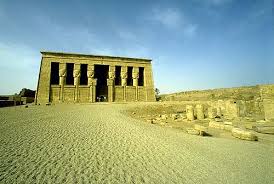1- History
Located rather isolated on the desert edge, about 2.5 km south-west of the Town, lay what Dendera is known for, the mostly Greco-Roman Temple Complex, Dendera, known in ancient Egyptian as Iunet or Tantere. The modern Arab town is built on the ancient site of Ta-ynt-netert which means 'She of the Divine Pillar', or Tentyra which is Greek for Dendera. It was once the capital of the 6th Nome (Pharaonic province) of Upper Egypt, also named Nikentori or Nitentori, which signifies willow wood or willow earth. Others give the derivation from the sky and fertility goddess Hathor, also associated with the Greek Aphrodite, who was specially worshiped there. The crocodile is recognized as the deity of the city and was also venerated as such in the other Egyptian cities, which caused many quarrels, notably with Ombos. It is still the seat of a titular see, suffragan of Ptolemais, in the former Roman province of Thebaid Secunda. Little is known of Christianity in that place, as only the names of two ancient bishops are given: Pachymius, companion of Melece at the beginning of the fourth century; and Serapion or Aprion, contemporary and friend of the monk St. Pachomius, who had in his diocese his celebrated convent of Tabennisi. It became the Arab Denderah, under late Ottoman rule a town of 6000 inhabitants in Qina.
2- The Temple
The Dendera Temple complex which contains the Temple of Hathor is one of the best preserved temples, if not the best, in all Egypt. The whole complex covers some 40,000 square meters and is surrounded by a hefty mud brick enclosed wall. The present building dates back to the times of the Ptolemaic dynasty and was completed by the Roman emperor Tiberius, but it rests on the foundations of earlier buildings dating back at least as far as Khufu (pyramid builder Cheops, second king of the 4th dynasty [c. 2613–c. 2494 BC]), in which was found the celebrated zodiac now in Paris; there are also the Roman and pharaonic Mammisi (birth houses), ruins of a Coptic church and a small chapel dedicated to Isis, of the Roman or Ptolemaic epoch. The area around the temple has had extensive landscaping, and now has a modern visitor centre, bazaar and small cafeteria.
3- Gallery





